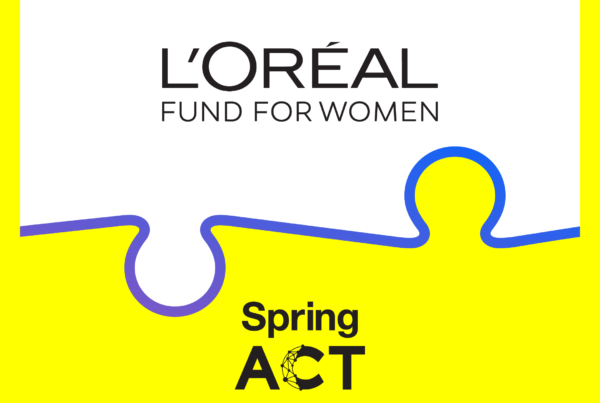Today marks the end of the International 16 Days of Activism Against Gender-Based Violence. Today is also International Human Rights Day. Especially today, I am reminded of my time in East Africa working with victims of violent crimes. With women who had been brutalised, beaten, and then shunned by society for being a victim of sexual attacks, often left with an infant to take care of as a result. As a human rights advocate, my daily work consists of facing humanity’s most horrific crimes and finding ways to help create a better future for all. Working in the field over the years, I have come to realise that there is one universal trend: victims of human rights violations are predominantly women.
1 in 3 women worldwide experience physical and/or sexual violence by their intimate partner. Let me say that again: 1 in 3 women. This means that you are guaranteed to know more than one woman who is suffering or has suffered from domestic abuse. Look around you. Abuse comes in many forms. It affects so many people, no matter where they are in the world, what level of education they have, or what background they come from. Violence against women, however, does not only affect women: children growing up in such households are often themselves subjected to abuse and have behavioural and schooling problems. As adolescents they are more prone to substance abuse. As adults, they themselves often sadly continue the cycle of violence and become perpetrators or victims of domestic abuse. Violence against women is so prevalent in every single country in the world, yet surprisingly little is done to put an end to it. Women are killed in the place where they should be safest. They’re killed in their own homes, most often by their partner – the very person they trust the most. So I ask: when roughly half of the world face deep-seated gender inequality on a daily basis, can we really say that women’s rights are human rights?
Are Women’s Rights Human Rights?
Human rights are rights we own based on the simple and only fact that we are human. They extend from the most fundamental – the right to life – to rights that ensure your liberty to live the life you want – the right to work, for instance. Article 1 of the Universal Declaration of Human Rights – alongside many conventions and resolutions promising the protection of women – clearly states: “All human beings are born free and equal in dignity and rights”. Yet are women really born equal when from their first cry as a little girl – or before they are even born – they are discriminated against? Can we truthfully talk about equality if women fear walking home after dark or fear suffering from abuse at the hands of their partner? In 1993, the UN adopted the first global instrument to expressly address this issue: The Declaration on the Elimination of Violence Against Women. It recognised that violence against women constitutes “a manifestation of historically unequal power relations between men and women” and that such violence violates women’s fundamental rights and freedoms. Violence against women is used as a tool of oppression, imposing domination over and discrimination of women in all corners of society. Until 1993, violence against women was considered a taboo and none of the government’s business. Up until that day, violence against women was accepted as an inevitable part of women’s lives. The question is, has this really changed? Do we as a society still accept violence against women as normal.
I know nothing of man’s rights, or woman’s rights; human rights are all that I recognize. – Sarah Moore Grimké
Where do we stand today?
The Declaration on the Elimination of Violence Against Women was a vital step in the right direction. Three decades later, however, violence against women prevails in every single country in the world. It has risen to such a degree, that in certain countries it legally amounts to femicide: the genocide of women. There is still a lack of funding and resources for organisations working tirelessly on the ground to help end violence against women. There is a lack of attention to this prevailing and widespread crime, which leaves criminals unpunished. There is also a lack of gender segregated data that can inform us on how best to address the issues at hand in order to bring about sustainable change. It seems as if the world does not yet quite understand that women are human beings in their own right and need to be treated as such.
Domestic violence is one the world‘s most widespread, devastating, and perpetual human rights violations. Yet it continues to go vastly unreported owing to the impunity of the perpetrators, the uncertainty and shame of the victims, the lack of institutional support for survivors, and the stigma and silence of the society. When it comes to crimes where the victims are predominantly women, the societies we live in tend towards blaming the victim. This sets the bar incredibly high for survivors to come forward. If a woman finds the courage to speak out about the crime being committed against her, the first reaction is to doubt her. If you report rape, it is about what you were wearing. If you report sexual harassment, it is about what you did to provoke it. If you report abuse, it is about your relationship dynamic. To put this in perspective: if you report a robbery, the first reaction is not to question the crime. The facts are looked at and investigated before any conclusions are drawn. Why is it different for crimes committed against women? It is long overdue to ensure survivors of gender-based violence feel empowered and supported to speak up.
So, what can you personally do, starting today, on International Human Rights Day 2020?
Everyone has a role to play in ending violence against women. Gender-based violence can happen to anyone anywhere. This is why it needs to be addressed by everyone everywhere. With “Sophia” we are building a tool that helps connect the diverse services (health, social support, legal, police) to the person in need in a way that leaves no digital trace for the abuser to find. “Sophia” empowers victims to Gather potential evidence, Assess their rights, and Learn their options (GAL). You can help us help survivors take their future into their own hands. Spread the word by sharing this article. Learn the signs to tell if someone’s in an abusive relationship. Step up for those people who really need you. All 193 countries of the world have made the commitment to “leave no one behind”. This cannot be achieved without putting an end to violence against women.
Enough to rape!
Enough to sexual harassment!
Enough to trafficking women!
Enough to femicide!
Enough to violence against women! Whether domestic or not.
The world needs a 0 tolerance approach, and you and I, we are part of this world. So let’s start today
If you are suffering from abuse and want to talk to someone, you can find your country’s national hotline to call here www.endvawnow.org (UN Women)
If you need more info in another language, please visit hotpeachpages.net
Share Post
* women, including everyone identifying as a woman.
** children and men are also victims of domestic abuse. For the purpose of this article – considering the disproportionate number of victims being women and this article falling within the International campaign to end gender-based violence – we are predominantly discussing women victims of domestic violence.



